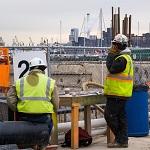Getting Coverage Under EPA's Construction General Permit
- Construction
Stormwater
Overview - Getting
Permit
Coverage - 2017
Construction
General Permit - Submitting an
NOI, NOT, or
Low Erosivity Waiver - Resources,
Tools, and
Templates
On this page:
- Who is responsible for getting permit coverage?
- Who do I get my permit from?
- What are the steps to obtain permit coverage?
- When do I have to submit my Notice of Intent (NOI)?
Who is responsible for getting permit coverage?
In general, you need to get covered under a Construction General Permit (CGP) and are responsible for submitting a Notice of Intent (NOI) if:
- Your site will disturb one or more acres of land, or less than one acre of land and is part of a common plan of development or sale that will ultimately disturb one or more acres of land; and
- You are an operator of a construction site and have control over:
- construction plans and specifications, including modifications to them; or
- daily site activities necessary to ensure compliance with the permit and the Stormwater Pollution Prevention Plan (SWPPP), including directing workers at the site to carry out permit compliance activities
Who do I get my permit from?
You can use the "Do I Need a Permit?" flow chart to help determine if and from whom you need to get NPDES permit coverage for your construction activities.
If your construction site is in any of the following areas, EPA is your NPDES permitting authority for construction stormwater discharges and you must seek coverage under EPA’s CGP:
- Idaho, Massachusetts, New Hampshire, New Mexico, and the District of Columbia;
- American Samoa, Guam, Johnston Atoll, Midway and Wake Islands, Northern Mariana Islands, and Puerto Rico;
- Indian Country lands within Alabama, Alaska, Arizona, California, Colorado, Connecticut, Florida, Idaho, Iowa, Kansas, Louisiana, Massachusetts, Michigan, Minnesota, Mississippi, Montana, Nebraska, Nevada, New Mexico, New York, North Carolina, North Dakota, Oklahoma, Oregon, Rhode Island, South Dakota, Texas, Utah, Virginia, Washington, Wisconsin, and Wyoming;
- Areas within Colorado, Delaware, Vermont, and Washington subject to construction by a federal operator;
- Denali National Park and Preserve; and
- Limited areas of Oklahoma and Texas.
See Appendix B: Permit Areas Eligible for Coverage for a complete and detailed list of areas eligible for coverage under EPA’s CGP.
If your construction site is in another location, please visit your State Agency’s NPDES website for more information. See state NPDES program contacts.
What are the steps to obtain permit coverage?
Step 1. Read the CGP and Fact Sheet
Step 2. Determine if you are eligible for coverage under this permit.
Before submitting your Notice of Intent (NOI), the form you file to obtain coverage under the CGP in step 4, you must:
- Determine if your site is located in an area eligible for coverage found in Appendix B of the 2017 CGP – Permit Areas Eligible for Coverage
- Follow the procedures in Appendix D of the 2017 CGP - Endangered Species Act (ESA) Requirements. Take note of the criterion (A, B, C, D, E or F) under which you are eligible because you will need to select this and provide supporting documentation in your NOI. See the Endangered Species Requirements page for more details on determining your ESA Eligibility under the CGP.
- Follow the procedures in Appendix E of the 2017 CGP – Historic Property Screening Process. Take note of your answers to the screening process questions because you will need to provide this information in your NOI.
Step 3. Develop a Stormwater Pollution Prevention Plan (SWPPP).
A SWPPP outlines how you plan to implement erosion and sediment controls and meet other requirements of the permit on your construction site. Before submitting your Notice of Intent (NOI), the form you file to obtain coverage under the CGP in step 4, you must develop the SWPPP consistent with the requirements in Part 7 of the CGP. You can use EPA’s SWPPP template to develop your SWPPP.
Step 4. Submit an NOI for your site using EPA's NPDES eReporting Tool (NeT) for the CGP.
When do I have to submit my Notice of Intent (NOI)?
To be covered under the 2017 CGP, you must submit your NOI by the deadline specified in the table below. The NOI certifies to EPA that you are eligible for coverage and provides information on your site’s construction activities and discharges.
|
Type of Operator |
Deadline to Submit NOI |
Permit Authorization Date |
|---|---|---|
|
Operator of a new site (i.e., a site where construction activities commence on or after February 16, 2017) |
At least 14 calendar days before commencing construction activities. |
14 calendar days after EPA notifies you that it has received a complete NOI, unless EPA notifies you that your authorization is delayed or denied. |
|
Operator of an existing site (i.e., a site with 2012 CGP coverage where construction activities commenced prior to February 16, 2017) |
No later than May 17, 2017. | |
| New operator of a permitted site (i.e., an operator that through transfer of ownership and/or operation replaces the operator of an already permitted construction site that is either a “new site” or an “existing site”) |
At least 14 calendar days before the date the transfer to the new operator will take place. |
|
|
Emergency-related project (i.e., a project initiated in response to a public emergency (e.g., mud slides, earthquake, extreme flooding conditions, disruption in essential public services), for which the related work requires immediate authorization to avoid imminent endangerment to human health or the environment, or to reestablish essential public services) |
No later than 30 calendar days after commencing construction activities. |
Provisionally covered under CGP terms and conditions immediately. |
